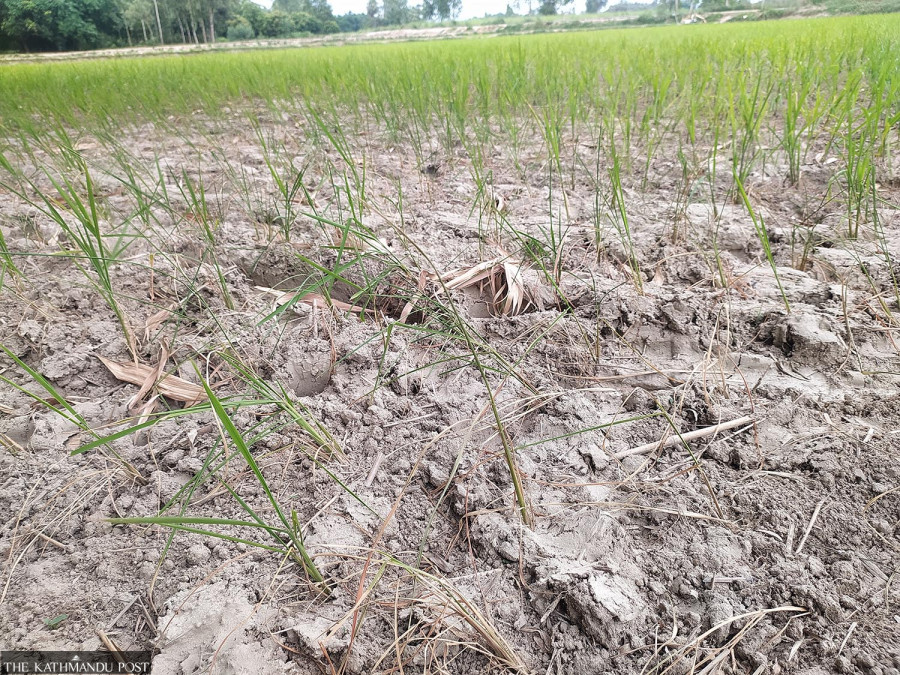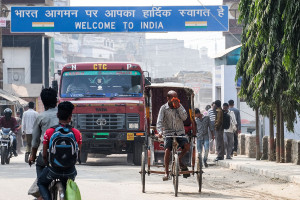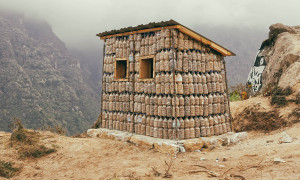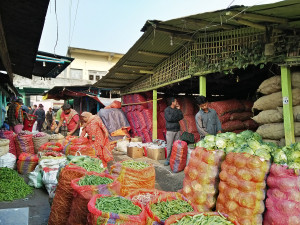Money
No rain means no rice in Madhesh
Monsoon failure, cracked soil, and wilting crops raise fears of sharp production declines.
Ajit Tiwari, Om Prakash Thakur & Shiva Puri
Ali Shekh, a farmer from Pipariya in ward 2 of Kabilasi Municipality in Sarlahi, usually cultivates paddy on four bigha (2.21 hectares) of land. His harvest not only feeds his family but also yields around 150 quintals for sale each year.
The income from those sales sustains his household. But his fields remain fallow this year, and the delayed paddy transplanting has him worried about major production losses.
With August just two days away, much of the farmland across Madhesh remains dry. Seedlings are withering from a lack of water, and many farmers, like Ali, fear they themselves may have to buy rice this year.
“I used to grow and sell rice every year. I may have to buy it for my family this time,” he said. “Managing household expenses will be difficult.”
Many farmers across the region echo his concerns. Those who managed to transplant paddy say their fields are cracking due to the dry conditions.
Puran Mahato from Farhadwa in ward 3 of Haripur Municipality has planted paddy on two bigha (1.35 hectares) and typically sells about 70 quintals a year. “This year, production will drop sharply. My field has deep cracks,” he said. “There might not be enough even for my own consumption.”
The Madhesh province government, which recently launched an ambitious “Feed the Nation” campaign to boost food grain output and national self-sufficiency, now faces a serious drought.
Despite being in the middle of the monsoon season, rainfall has been almost nonexistent. Apart from the previous fiscal year, when rains were plentiful, the five districts in Madhesh have consistently struggled with water shortages.
The federal government initiated the Rs87 billion Sunkoshi Marin Diversion Project in Sindhuli and Ramechhap districts to address irrigation needs. This project aims to channel water from the Sunkoshi River into the Bagmati River to irrigate 122,000 hectares of farmland in Rautahat, Dhanusha, Mahottari, Sarlahi, and Bara.
Of the total investment, Rs37.3 billion is earmarked for the irrigation component alone. The project, declared a national pride initiative on January 20, 2020, is scheduled for completion by July 2027.
A key component of the scheme—the Rs10.05 billion diversion tunnel—achieved a breakthrough in May last year, six months ahead of schedule. The 13.3-km tunnel is designed to redirect part of the Sunkoshi’s flow into the Marin River, a tributary of the Bagmati, helping irrigate central Tarai farmland.
However, officials admit that progress on the irrigation infrastructure has slowed to a crawl.
Madhesh’s fields remain parched as the delay drags on, and transplanted rice plants are withering. Cracks are visible in the soil, and once lush fields now lie dusty and barren. The extreme heat, intensified by the absence of rain and blazing sun from early morning, has disrupted daily life. Even drinking water has become scarce.
The drought is disrupting rice transplantation in what is considered the country’s breadbasket, and agricultural experts are warning of a potential food crisis and rising prices.
Due to the expanse of its cultivated land, Madhesh is Nepal’s top agricultural production zone. It produces 25.3 percent of the country’s total paddy, 32.1 percent of its wheat, 77.1 percent of mangoes, 66.5 percent of sugarcane, 22.1 percent of oilseeds, 37 percent of pulses, 57.9 percent of fish, 18.12 percent of milk, and 21.93 percent of bananas.
These crucial crops and livestock outputs are now threatened due to insufficient rains.
Of the 542,580 hectares of arable land in the province, 362,344 hectares are allocated for summer paddy, and 20,839 hectares for spring paddy.
Agriculture, forestry, and fishery contribute the highest share—36.73 percent—to Madhesh’s GDP.
However, spring planting (March to April) was abandoned this year due to drought.
Data from the Ministry of Agriculture and Livestock Development show that only 51 percent of the paddy fields in Madhesh have been planted this summer.
Experts say paddy transplanting in the Tarai can extend into early September, though such delays inevitably impact yield.
“Transplanting is significantly delayed. We aim to complete it by August by speeding up irrigation efforts,” said Saroj Chaudhary, spokesperson for the Ministry of Land Management, Agriculture and Cooperatives in the Madhesh province. “Delayed planting reduces yields. But if it rains by the end of July, the damage might be minimal—we estimate only a slight drop.”
In the last fiscal year, Madhesh’s paddy output reached a record 1.48 million tonnes (including 126,861 tonnes of spring paddy), up 11 percent from the year before. Productivity stood at 3.96 tonnes per hectare. Officials credit that performance to consistent rainfall and an improved supply of chemical fertiliser.
“If this drought continues, we’ll see a sharp drop in production. Though it’s too early for a detailed estimate, we anticipate a major decline,” Chaudhary added. “Let’s wait 10 to 12 more days. If transplanting resumes with rainfall, losses can still be contained.”
Despite its role as Nepal’s agricultural heartland, only 49 percent of Madhesh’s arable land has access to irrigation. Due to the extended dry spell, existing systems—rivers, ponds, canals, tube wells, and deep borings—are struggling.
“We’ve issued directives to adopt alternative irrigation methods,” said Chaudhary. “We’re also working with the Nepal Agricultural Research Council to explore crop alternatives if dry conditions persist.”
Agriculture is not just an economic mainstay—it is the core livelihood for most Madhesh residents.
As rainfall continued to evade the region, the Madhesh government declared all eight of its districts drought-hit.
On July 23, the federal government followed suit, designating Madhesh a disaster zone. Prime Minister KP Sharma Oli conducted an aerial inspection of the affected areas.
Though Madhesh covers just 6.5 percent of Nepal’s land area, it houses nearly 21 percent of the population.
Sohan Sah, vice-chair of the Province Policy and Planning Commission, acknowledged the setback: “The drought has derailed our Feed the Nation campaign. Madhesh is the country’s food bowl. This drought threatens that very identity,” he said. “Climate change is hitting Madhesh the hardest. It’s a wake-up call.”
According to the Malangawa Agriculture Knowledge Centre, paddy from Sarlahi—varieties like Kariyakomod, Basmati, Rambilas, and Sona—is typically sold in Kathmandu, Pokhara, and Birgunj due to their high demand. But the current drought has also damaged other crops like vegetables and sugarcane.
Pramod Thapaliya, chairperson of the Lalbandi Vegetable Management Committee, confirmed that sugarcane is withering and vegetable yields are falling.
Sarlahi generally cultivates paddy on 40,000 hectares, wheat on 30,000 hectares, maize on 16,000 hectares, vegetables on 13,000 hectares, and sugarcane on 21,000 hectares.
Jogindra Sah, a 68-year-old farmer from Sheetalpur in ward 1 of Fatuwa Bijaypur Municipality in Rautahat, installed a borehole pump for the first time this year in response to the drought. After transplanting paddy on his two bigha, he’s been sharing water from his pump with neighbours. “Planting is usually done by mid-July. This year, there was no rain,” he said. “I spent Rs50,000 on the borehole. Now others are using it too.”
While his paddy has started greening, surrounding fields remain barren. Farmers without boreholes are buying water from others to irrigate their fields, but even the transplanted crops are struggling. Although the government declared the area a disaster zone and sent technical teams, many farmers say meaningful support has yet to reach them.
Surendra Prasad Kurmi, head of the Agriculture Knowledge Centre in Rautahat, said that over 60 percent of transplanting has been achieved, largely thanks to boreholes and the Bagmati Irrigation Project. “Boreholes help, but we still desperately need rainfall. Otherwise, yields will be poor,” he said. “If planting isn’t completed by mid-August, the rice crop will be severely hit.”
Rautahat has 38,500 hectares of arable land. Yet much of the farmland in Maulapur and Ishnath remains uncultivated. Farmers fear that their seedlings will not survive.
“I left 10 kattha (0.34 hectares) of land fallow,” said Rampravesh Yadav from Banjraha in Ishnath, Rautahat. “There’s no water source. If it rains, I’ll plant. If not, I’ll abandon it.”




 18.12°C Kathmandu
18.12°C Kathmandu
















